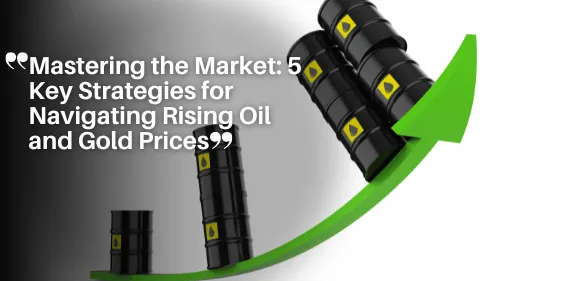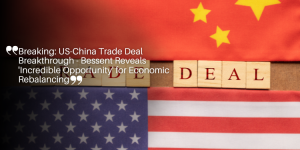Mastering the Market: 5 Key Strategies for Navigating Rising Oil and Gold Prices

Surge in Oil Prices and Record-Breaking Gold Rallies
The investment landscape is experiencing a whirlwind of changes, with surging oil prices and gold reaching record highs.
This environment presents both opportunities and challenges for investors.
Understanding the driving forces behind these movements is crucial.
Gas prices have skyrocketed by over 17% since December 2023, surpassing $3.05 per gallon.
This increase is a symptom of strained global supply chains and escalating geopolitical tensions, particularly in the Middle East.
For instance, Energy Information Administration data reflect these challenges.
Impact on Energy Select Sector SPDR Fund (XLE)
The Energy Select Sector SPDR Fund (XLE), which heavily invests in major energy companies, has seen its share price enter overbought territory. This reflects the upward trajectory of oil prices.
While further escalation in regions like the Middle East could push XLE shares higher, caution is warranted.
A possibly overheated market heightens the risk of a sudden correction.
Global Supply Chain Issues and Geopolitical Tensions
The interconnectedness of global markets means that supply chain issues and geopolitical events have broad implications.
The recent reaffirmation of intentions to invade Rafah by Prime Minister Benjamin Netanyahu, combined with dimming hopes for a Gaza ceasefire, resulted in immediate market reactions.
Oil futures saw a marginal increase, highlighting the market’s sensitivity to geopolitical developments.
Throughout this high-stakes environment, maintaining strategic vigilance and a disciplined approach is essential.
This landscape necessitates balancing potential gains with the risk of volatility.
As we navigate these tumultuous waters, it’s vital to understand the underlying factors driving these price movements and how they impact our investment strategies.
Analyzing the Oil Market Dynamics
Gas Price Surge Since December 2023
Since December 2023, gas prices have soared by over 17%, breaking the $3.053 per gallon mark according to data from the Energy Information Administration. This sharp increase is primarily attributed to ongoing global supply chain disruptions.
These supply chain issues create bottlenecks, limiting the availability of oil and driving up prices as demand remains constant or increases.
Geopolitical Factors Influencing Oil Futures
Geopolitical tensions are another significant factor influencing oil futures.
Prime Minister Benjamin Netanyahu’s recent statements regarding potential actions in Rafah amid decreased chances for a Gaza ceasefire have spooked the markets, leading to marginal increases in oil futures.
Such geopolitical developments underscore the sensitivity of global energy markets to instability and highlight the interconnected nature of international events.
It’s a clear reminder that oil prices are not just a reflection of supply and demand but also of geopolitical dynamics.
Risks and Opportunities in Energy Sector Investments
The rising oil prices present both risks and opportunities for investors, particularly in funds like the Energy Select Sector SPDR Fund (XLE).
Potential Risks
- Market Overheating: The XLE fund has seen its share price enter overbought territory. This could indicate an overheated market, raising the risk of a sharp correction.
- Geopolitical Instability: Any further escalation in geopolitical tensions, particularly in the Middle East, could introduce additional volatility in the market.
Potential Opportunities
- Continue Rising: If geopolitical tensions persist, oil prices and consequently the XLE shares could rise even higher, potentially reaching the projected $100 per share.
- Long-term Growth: Despite the current volatility, long-term demand for energy continues to grow, providing a solid foundation for future gains in energy investments.
Balancing these risks and opportunities is crucial for investors seeking to navigate the current market landscape effectively.
Ensuring a disciplined approach and strategic vigilance helps to capitalize on potential gains while mitigating associated risks.
Maintaining this careful balance is essential as we move toward exploring the dynamics of the gold market and other investment strategies.
Decoding the Gold Market Rally
Factors Driving Gold Prices to Record Highs
Historically, gold has always been seen as a safe-haven asset, and the current market situation is no exception.
Several interconnected factors are driving gold prices to record highs:
- Inflation Concerns: Persistent inflationary pressures are a significant concern for investors worldwide. Rising costs of goods and services erode the purchasing power of currencies, making gold a more attractive investment option as a hedge against inflation.
- Geopolitical Turmoil: Ongoing geopolitical tensions, particularly in volatile regions like the Middle East, inject a high degree of uncertainty into the global markets. Gold shines brighter during such uncertain times, symbolizing safety and stability for investors looking to protect their wealth.
- Weakening US Dollar: The US dollar’s recent signs of weakening make gold, which is priced in US dollars, more affordable for international investors using other currencies. This increased demand from abroad contributes to the rise in gold prices.
Projections for Gold Prices in 2024 and 2025
Financial giants UBS and Bank of America (BofA) have provided optimistic forecasts for gold prices.
UBS projects that retail investor and ETF buying will continue driving demand. Bank of America goes a step further, anticipating gold prices to reach $2,500 per ounce by the end of 2024 and potentially hitting $3,000 per ounce by 2025.
This bullish outlook stems from ongoing inflation and geopolitical uncertainties, alongside a weakening dollar.
Gold as a Hedge Against Inflation and Geopolitical Instability
Investors often flock to gold during periods of economic instability precisely because it acts as a hedge against inflation and geopolitical risks.
Unlike fiat currencies, gold retains its value, making it a reliable store of wealth. Given the current economic landscape marked by supply chain disruptions and political tensions, gold’s role as a risk mitigator is more pertinent than ever.
The preceding discussions have highlighted the critical factors influencing both the oil and gold markets.
As these dynamics continue to evolve, it becomes essential for investors to develop a balanced approach to navigate the complexities of these volatile markets effectively.
Developing a Balanced Investment Approach
Importance of Strategic Vigilance in Volatile Markets
Navigating the ups and downs of the current market landscape requires more than just a keen eye for trends; it demands strategic vigilance. With oil prices surging and gold hitting record-breaking rallies, maintaining an active approach is crucial.
The Energy Information Administration has reported a substantial gas price increase of over 17% since December 2023, largely driven by global supply chain disruptions and geopolitical tensions in the Middle East.
For investors in funds like Energy Select Sector SPDR Fund (XLE) and SPDR Gold Shares (GLD), this underscores the need to stay on top of market dynamics through meticulous tracking and timely adjustments.
Balancing Risk and Reward in Oil and Gold Investments
Finding the right equilibrium between risk and reward can be tricky, particularly in such volatile times.
The XLE fund, for instance, has seen its share price enter overbought territory, propelled further by geopolitical conflicts.
This volatility presents both opportunities and risks. Similarly, gold has soared to unprecedented highs, driven by persistent inflation, geopolitical instability, and a weakening US dollar.
Industry projections from giants like UBS and Bank of America suggest gold prices could reach $2,500 per ounce by 2024, and possibly $3,000 by 2025.
These projections emphasize the potential upside but also highlight the importance of being cautious not to get caught in the hype.
Avoiding Market Euphoria and Maintaining a Disciplined Approach
Market euphoria can be intoxicating, but it’s crucial to keep a level head. When excitement runs high, the temptation to chase gains can lead to poor investment decisions.
Reports indicate that retail investor and ETF buying may drive XLE and GLD shares higher in the near term.
However, it’s essential to exercise caution and avoid the herd mentality.
A disciplined approach ensures that you don’t fall victim to market exuberance. By focusing on long-term strategy over short-term gains, you can better manage the risks and rewards, securing your portfolio’s health for the future.
Investing in today’s high-stakes environment calls for strategic vigilance, balanced risk-taking, and a commitment to disciplined investing. This approach not only prepares you to capitalize on opportunities but also safeguards your investments against potential pitfalls.
Implementing Effective Risk Management Strategies
Active Monitoring of Market Dynamics
In times of heightened market volatility, like the current surge in oil and gold prices, active monitoring becomes a crucial strategy.
Regularly tracking price movements, understanding the economic indicators, and staying informed about geopolitical developments can help investors anticipate market shifts and make informed decisions.
For instance, the recent 17% increase in gas prices since December 2023 fueled by geopolitical tensions in the Middle East is a reminder of how quickly market dynamics can change.
Strategic Profit-Taking to Secure Gains
Strategic profit-taking allows investors to lock in gains amidst market uncertainties. By setting specific target prices for investments like the Energy Select Sector SPDR Fund (XLE) and taking profits once those targets are met, investors can ensure they capitalize on upward trends without succumbing to market euphoria.
For example, if XLE shares, which have been volatile recently, approach elevated target prices, partial profit-taking can help secure returns while still maintaining a position in potentially rising stocks.
Maintaining Portfolio Resilience in Uncertain Conditions
Staying resilient in volatile markets requires a balanced and well-strategized approach.
Diversifying investments across different sectors and asset classes can mitigate risks. Gold, for instance, serves as a hedge against inflation and geopolitical risks. Maintaining a diversified portfolio helps protect against market downturns in any one sector.
Moreover, carefully balancing the weight of highly volatile assets like oil and gold within this portfolio ensures that no single investment overexposes investors to market swings.
Timely adjustments in response to market changes are essential for maintaining portfolio stability.
Investors should be prepared to rebalance portfolios periodically, ensuring a healthy mix of assets aligned with current market conditions and long-term financial goals.
By incorporating these risk management strategies, investors can navigate the complexities of rising oil and gold prices, securing gains while maintaining portfolio health amidst volatility.







